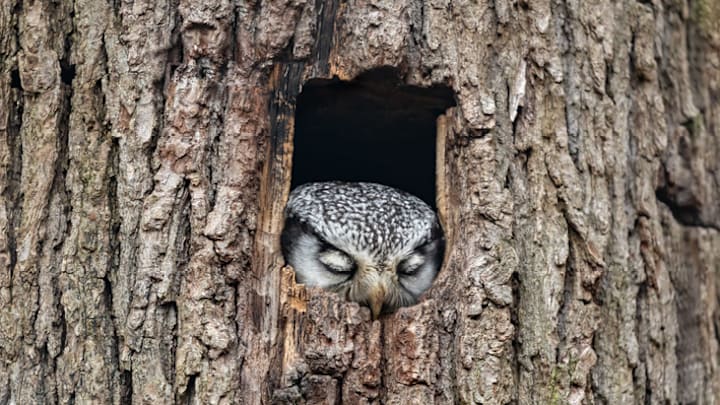Birds can be classified into two groups: diurnal and nocturnal. Most birds are diurnal, meaning they are awake during daylight hours. Nocturnal birds, such as owls, are awake at night. But at some point, all birds need to sleep. How do they do it?
Not all that differently from humans, actually. Mammals and birds experience two states of sleep: slow wave sleep (SWS), which is dreamless, light sleep; and rapid eye movement (REM) sleep, which is deep and associated with vivid dreaming and slower brain activity. Birds undergo REM sleep for a shorter time than mammals (usually lasting 16 seconds), but do not necessarily get less REM sleep overall. Scientists once thought only mammals and birds share these sleep patterns, but we now know some reptiles do as well.
Different bird species have evolved unique ways of sleeping to get sufficient shut-eye while living in the wild. Pigeons, for example, tend to power nap. And migrating birds such as sparrows drastically reduce the hours they sleep while still being able to function normally.
The Benefits of Sleep for Birds
The benefits of sleep are shared across the animal kingdom. Sleep saves energy by slowing down the metabolism and allows animals to avoid high-energy activities. For vertebrates, sleep is an essential part of brain development, strengthening brain cell connections and memory [PDF].

Lack of sleep or disrupted sleep patterns can affect the learning and memory development of young birds. Artificial light can also disrupt birds’ sleep: they get less deep, REM sleep, especially in urban areas where artificial light is of a high intensity [PDF]. Some disoriented birds may also fly around artificial light in circles, or worse, crash into lit-up buildings.
Sleeping can even improve some birds’ ability to remember their songs. In 2008, scientists discovered that young zebra finches practice songs they heard from adult finches in their sleep. Improvements in the young birds’ songs were evident the next day. They may even be able to learn new songs while snoozing.
Unusual Sleep Habits
Sleep has its obvious benefits, but sleeping too much or too deeply can be dangerous in the wild.
Some birds have adapted their patterns of sleep to cope with the threat of predators. Chinstrap penguins avoid going into full sleep so they can stay vigilant and watch over their young chicks. Instead, they take napping to the extreme and have almost 10,000 “micro-naps” a day. This adds up to a comfortable 11 hours of sleep.

Another solution to the predator problem is to literally sleep with one eye open. Ducks and ostriches are capable of being in a state of half sleep called sleep-watching, and doze with one eye open towards where predators might approach.
Can Birds Sleep While Flying?
A few bird species can half-sleep while flying. In 2016, scientists made a groundbreaking discovery that a type of seabird called a frigatebird can sleep while flying. One or both halves of their brain may be asleep in-flight, allowing the birds to fly continuously when migrating without needing to stop for a nap. If a frigatebird is sleeping with one eye open, the likely reason is so they don’t crash into other birds or obstacles, rather than watching for predators.
Despite this extraordinary feat, frigatebirds get less than an hour’s sleep per day when migrating. It is still a mystery as to how or why they don’t become sleep deprived. More recently, scientists have found that swifts also sleep airborne.

Only one bird species—the common poorwill—hibernates. Hibernation is a state of regulated hypothermia that can last for a few weeks or for months on end. Hibernating animals lower their metabolism, body temperature, and heart rate to conserve more energy than they can during regular sleep. The common poorwill’s mottled feathers camouflage it against the ground in meadows and shrublands where it hibernates.
Hummingbirds enter a similar state called torpor, or temporary hibernation. Torpor usually lasts for a few hours, but hummingbirds can enter a deep torpor that lasts all night, during which time they may drop their body temperature by about 20°F. For context, a drop of 3°F in the human body would lead to hypothermia and require medical attention. Scientists are still trying to figure out how a hummingbird can warm itself back up from deep torpor every morning.
Read More Stories About Birds:
